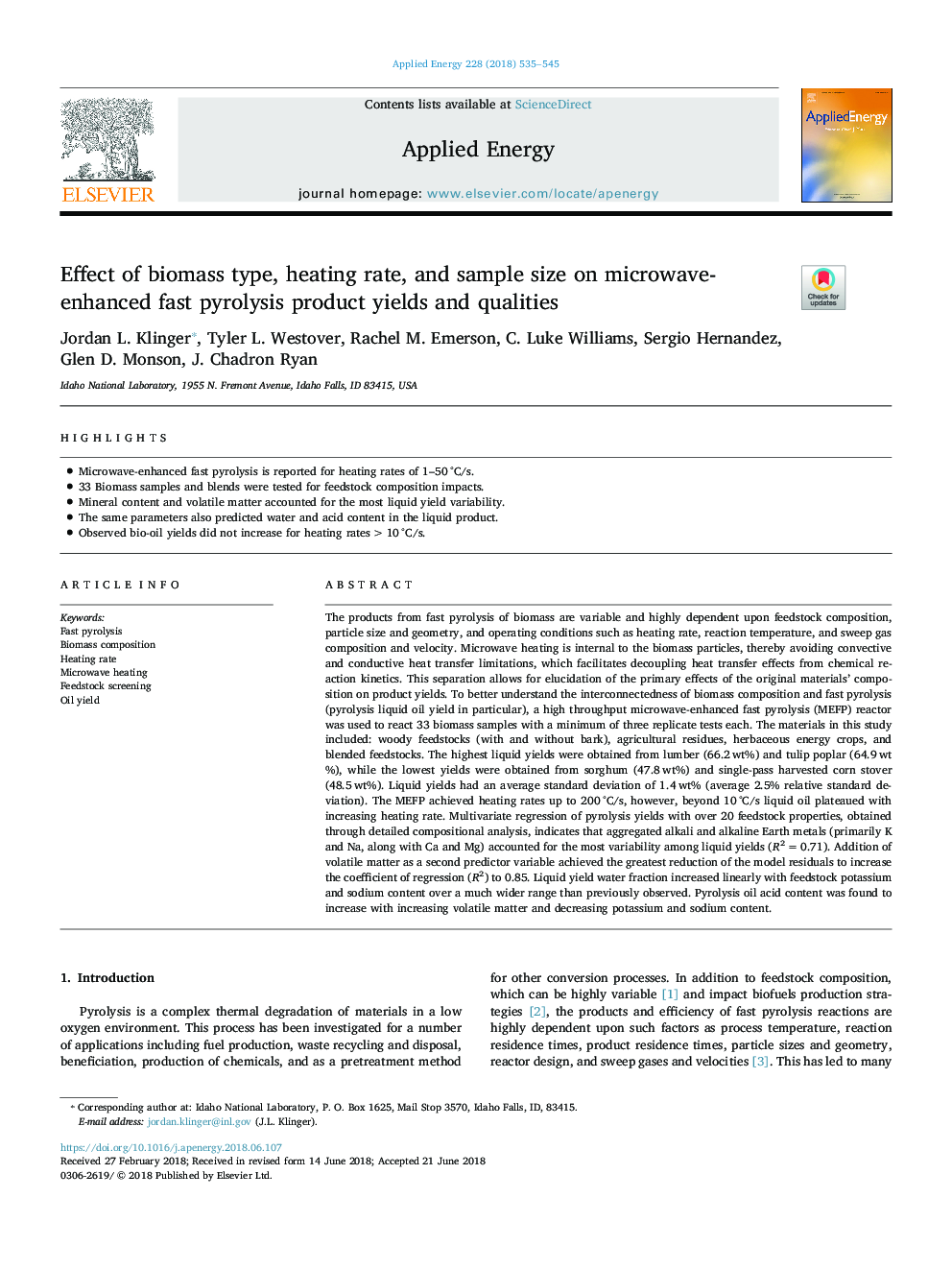| کد مقاله | کد نشریه | سال انتشار | مقاله انگلیسی | نسخه تمام متن |
|---|---|---|---|---|
| 6679734 | 1428063 | 2018 | 11 صفحه PDF | دانلود رایگان |
عنوان انگلیسی مقاله ISI
Effect of biomass type, heating rate, and sample size on microwave-enhanced fast pyrolysis product yields and qualities
ترجمه فارسی عنوان
اثر نوع زیست توده، میزان گرما و اندازه نمونه بر تولید و ویژگی های محصولات سریع پیرولیز سریع مایکروویو
دانلود مقاله + سفارش ترجمه
دانلود مقاله ISI انگلیسی
رایگان برای ایرانیان
کلمات کلیدی
پیرولیز سریع، ترکیب زیست توده، نرخ گرمایش، گرمایش مایکروویو، غربالگری مواد اولیه، عملکرد روغن،
موضوعات مرتبط
مهندسی و علوم پایه
مهندسی انرژی
مهندسی انرژی و فناوری های برق
چکیده انگلیسی
The products from fast pyrolysis of biomass are variable and highly dependent upon feedstock composition, particle size and geometry, and operating conditions such as heating rate, reaction temperature, and sweep gas composition and velocity. Microwave heating is internal to the biomass particles, thereby avoiding convective and conductive heat transfer limitations, which facilitates decoupling heat transfer effects from chemical reaction kinetics. This separation allows for elucidation of the primary effects of the original materials' composition on product yields. To better understand the interconnectedness of biomass composition and fast pyrolysis (pyrolysis liquid oil yield in particular), a high throughput microwave-enhanced fast pyrolysis (MEFP) reactor was used to react 33 biomass samples with a minimum of three replicate tests each. The materials in this study included: woody feedstocks (with and without bark), agricultural residues, herbaceous energy crops, and blended feedstocks. The highest liquid yields were obtained from lumber (66.2â¯wt%) and tulip poplar (64.9â¯wt%), while the lowest yields were obtained from sorghum (47.8â¯wt%) and single-pass harvested corn stover (48.5â¯wt%). Liquid yields had an average standard deviation of 1.4â¯wt% (average 2.5% relative standard deviation). The MEFP achieved heating rates up to 200â¯Â°C/s, however, beyond 10â¯Â°C/s liquid oil plateaued with increasing heating rate. Multivariate regression of pyrolysis yields with over 20 feedstock properties, obtained through detailed compositional analysis, indicates that aggregated alkali and alkaline Earth metals (primarily K and Na, along with Ca and Mg) accounted for the most variability among liquid yields (R2â¯=â¯0.71). Addition of volatile matter as a second predictor variable achieved the greatest reduction of the model residuals to increase the coefficient of regression (R2) to 0.85. Liquid yield water fraction increased linearly with feedstock potassium and sodium content over a much wider range than previously observed. Pyrolysis oil acid content was found to increase with increasing volatile matter and decreasing potassium and sodium content.
ناشر
Database: Elsevier - ScienceDirect (ساینس دایرکت)
Journal: Applied Energy - Volume 228, 15 October 2018, Pages 535-545
Journal: Applied Energy - Volume 228, 15 October 2018, Pages 535-545
نویسندگان
Jordan L. Klinger, Tyler L. Westover, Rachel M. Emerson, C. Luke Williams, Sergio Hernandez, Glen D. Monson, J. Chadron Ryan,
